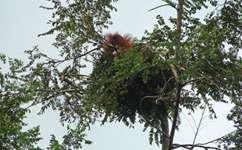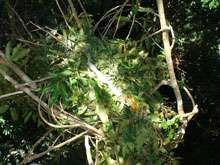Orangutan nests reveal engineering expertise

An innovative study looking at how orangutans build their nests has revealed that the apes use a high level of engineering know-how.
A team of UK researchers found that they bend and half-break thick branches which they use to build the structure of their nests. But then they break off smaller branches and twigs for the lining – presumably to make their nests more comfortable.
'It's clear orangutans use their knowledge of the mechanics of how different types of branches break to make their nests,' says Adam van Casteren from the University of Manchester, lead author of the study, which is published in Proceedings of the National Academy of Sciences.
'The degree of technical knowledge they use gives us clues about the evolution of tool use and technology in human ancestors,' he adds.
Van Casteren originally went to Sumatra in Indonesia to measure the flexibility of various branches of different sizes and film orangutans walking upright. 'The idea was to find out if walking bipedally lets them conserve energy,' he says.
In the meantime, van Casteren's supervisor, Roland Ennos – also from the University of Manchester – had worked out why some branches are harder to break than others. So he suggested that van Casteren look at how orangutans do this when building their nests.
'We wanted to know more about the mechanical design and architecture of orangutan nests and work out how technically sophisticated they are and whether or not they use the natural mechanics of branches,' explains van Casteren.
When orangutans want to take a break from foraging, or rest for the night, they build large, oval nests high up in the rainforest canopy. Researchers think these nests mean the apes get a good night's sleep compared with sleeping on the ground or on branches.
An undisturbed night would also help them get more rapid eye movement (REM) sleep – thought to be important for bigger-brained creatures. The nests might also offer protection from predators like Sumatran tigers and maybe critters like mosquitoes.
But instead of going back to the same nests, orangutans build a new bed from scratch every time, sometimes building multiple nests a day. This is almost certainly because they roam over such large areas.
After choosing a suitable location, orangutans bend and break branches inwards, weaving and twisting them to lock them into the basic structure of the nest. They then add layers of smaller branches on top of this construction to make a kind of mattress. Some orangutans also fashion themselves a roof or pillow for added comfort.
'They're solid structures and only take orangutans about 10 to 15 minutes to build,' says van Casteren.
He measured how flexible the nests were, then analysed how the branches had been bent or broken and their mechanical properties.

He found the middle of the nest is much more pliable than the edges, which is stiffer. The authors suggest this arrangement could add both safety and comfort to the whole structure.
Van Casteren, Ennos and colleagues from the universities of Birmingham, Liverpool and London think orangutans use the fact that branches tend to only break half-way across in a so-called greenstick fracture to build the structural component of their nests. So, they end up choosing thicker branches which are stronger and more rigid.
'They bend and half break thick branches to make the structure, then break off thinner twigs to line the nest and make it comfy,' explains Ennos.
'This shows that they seem to have some engineering knowledge, probably using diameter as a way of determining branch rigidity, which has implications about the evolution of intelligence,' he adds.
'We think the skills you'd need to build such a sophisticated nest are on a par with those you'd need to make and use tools, so require a similar cognitive ability. In this context, it would be interesting to investigate nest-building by other animals like beavers and birds,' says van Casteren.
More information: Adam van Casteren, William I. Sellers, Susannah K. S. Thorpe, Sam Coward, Robin H. Crompton, Julia P. Myatt, and A. Roland Ennos, Nest-building orangutans demonstrate engineering know-how to produce safe, comfortable beds, Proceedings of the National Academy of Sciences, published 16 April 2012, www.pnas.org/cgi/doi/10.1073/pnas.1200902109
Provided by PlanetEarth Online
This story is republished courtesy of Planet Earth online, a free, companion website to the award-winning magazine Planet Earth published and funded by the Natural Environment Research Council (NERC).


















